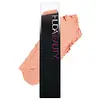Kryolan TV Paint Stick Versus Huda Beauty Fauxfilter Skin Finish Buildable Coverage Foundation Stick
What's inside
What's inside
 Key Ingredients
Key Ingredients

 Benefits
Benefits

 Concerns
Concerns

 Ingredients Side-by-side
Ingredients Side-by-side

Paraffinum Liquidum
EmollientParaffin
PerfumingEuphorbia Cerifera Wax
Hydrogenated Polyisobutene
EmollientOctyldodecanol
EmollientCaprylic/Capric Triglyceride
MaskingCetyl Palmitate
EmollientPetrolatum
EmollientKaolin
AbrasiveCera Alba
EmollientTocopherol
AntioxidantOleth-10
EmulsifyingLaneth-40
CleansingCopernicia Cerifera Wax
Polybutene
Lanolin Alcohol
EmollientPropylene Glycol
HumectantBHT
AntioxidantAscorbyl Palmitate
AntioxidantGlyceryl Stearate
EmollientCetearyl Alcohol
EmollientCitric Acid
BufferingBenzyl Alcohol
PerfumingLinalyl Acetate
MaskingAlpha-Isomethyl Ionone
PerfumingLinalool
PerfumingAcetyl Cedrene
Cinnamyl Alcohol
PerfumingJuniperus Virginiana Oil
MaskingCitronellol
PerfumingAmyl Salicylate
PerfumingHexyl Cinnamal
PerfumingPogostemon Cablin Leaf Oil
MaskingBenzyl Salicylate
PerfumingCoumarin
PerfumingGeraniol
PerfumingBenzyl Benzoate
AntimicrobialGeranyl Acetate
PerfumingAnethole
MaskingEugenol
PerfumingParfum
MaskingTitanium Dioxide
Cosmetic ColorantCI 77891
Cosmetic ColorantIron Oxides
CI 77491
Cosmetic ColorantCI 77492
Cosmetic ColorantCI 77499
Cosmetic ColorantUltramarines
CI 77007
Cosmetic ColorantCI 19140
Cosmetic ColorantCI 15850
Cosmetic ColorantCI 75470
Cosmetic ColorantCI 12085
Cosmetic ColorantCI 15985
Cosmetic ColorantCopper Powder
AntimicrobialCI 77400
Cosmetic ColorantBronzite Powder
Cosmetic ColorantChromium Hydroxide Green
CI 77289
Cosmetic ColorantCI 77510
Cosmetic ColorantBlue 1 Lake
Cosmetic ColorantCI 42090
Cosmetic ColorantCI 16035
Cosmetic ColorantEpoxy Resin Coated Aluminum Powder
Cosmetic ColorantChromium Oxide Greens
CI 77288
Cosmetic ColorantCI 45380
Cosmetic ColorantMica
Cosmetic ColorantTin Oxide
AbrasiveParaffinum Liquidum, Paraffin, Euphorbia Cerifera Wax, Hydrogenated Polyisobutene, Octyldodecanol, Caprylic/Capric Triglyceride, Cetyl Palmitate, Petrolatum, Kaolin, Cera Alba, Tocopherol, Oleth-10, Laneth-40, Copernicia Cerifera Wax, Polybutene, Lanolin Alcohol, Propylene Glycol, BHT, Ascorbyl Palmitate, Glyceryl Stearate, Cetearyl Alcohol, Citric Acid, Benzyl Alcohol, Linalyl Acetate, Alpha-Isomethyl Ionone, Linalool, Acetyl Cedrene, Cinnamyl Alcohol, Juniperus Virginiana Oil, Citronellol, Amyl Salicylate, Hexyl Cinnamal, Pogostemon Cablin Leaf Oil, Benzyl Salicylate, Coumarin, Geraniol, Benzyl Benzoate, Geranyl Acetate, Anethole, Eugenol, Parfum, Titanium Dioxide, CI 77891, Iron Oxides, CI 77491, CI 77492, CI 77499, Ultramarines, CI 77007, CI 19140, CI 15850, CI 75470, CI 12085, CI 15985, Copper Powder, CI 77400, Bronzite Powder, Chromium Hydroxide Green, CI 77289, CI 77510, Blue 1 Lake, CI 42090, CI 16035, Epoxy Resin Coated Aluminum Powder, Chromium Oxide Greens, CI 77288, CI 45380, Mica, Tin Oxide
Cetyl Ethylhexanoate
EmollientOctyldodecanol
EmollientSilica
AbrasiveSynthetic Beeswax
Emulsion StabilisingMica
Cosmetic ColorantHydrogenated Coconut Oil
EmollientCaprylyl Methicone
Skin ConditioningCyclopentasiloxane
EmollientSynthetic Wax
AbrasiveDiphenyl Dimethicone
EmollientEthylene/Propylene Copolymer
AbrasiveSilica Dimethyl Silylate
EmollientTocopheryl Acetate
AntioxidantGlyceryl Caprylate
EmollientCaprylyl Glycol
EmollientEthylhexylglycerin
Skin ConditioningAluminum Hydroxide
EmollientEthylhexyl Methoxycinnamate
UV Absorber1,2-Hexanediol
Skin ConditioningTriethoxycaprylylsilane
Iron Oxides
CI 77891
Cosmetic ColorantUltramarines
Cetyl Ethylhexanoate, Octyldodecanol, Silica, Synthetic Beeswax, Mica, Hydrogenated Coconut Oil, Caprylyl Methicone, Cyclopentasiloxane, Synthetic Wax, Diphenyl Dimethicone, Ethylene/Propylene Copolymer, Silica Dimethyl Silylate, Tocopheryl Acetate, Glyceryl Caprylate, Caprylyl Glycol, Ethylhexylglycerin, Aluminum Hydroxide, Ethylhexyl Methoxycinnamate, 1,2-Hexanediol, Triethoxycaprylylsilane, Iron Oxides, CI 77891, Ultramarines
Ingredients Explained
These ingredients are found in both products.
Ingredients higher up in an ingredient list are typically present in a larger amount.
Ci 77891 is a white pigment from Titanium dioxide. It is naturally found in minerals such as rutile and ilmenite.
It's main function is to add a white color to cosmetics. It can also be mixed with other colors to create different shades.
Ci 77891 is commonly found in sunscreens due to its ability to block UV rays.
Learn more about CI 77891Mica is a naturally occurring mineral used to add shimmer and color in cosmetics. It can also help improve the texture of a product or give it an opaque, white/silver color.
Serecite is the name for very fine but ragged grains of mica.
This ingredient is often coated with metal oxides like titanium dioxide. Trace amounts of heavy metals may be found in mica, but these metals are not harmful in our personal products.
Mica has been used since prehistoric times throughout the world. Ancient Egyptian, Indian, Greek, Roman, Aztec, and Chinese civilizations have used mica.
Learn more about MicaOctyldodecanol is a fatty alcohol. It is primarily used to enhance the texture of products.
As an emulsifier, Octyldodecanol helps prevent the oils and waters from separating. It also prevents ingredients from creating foam when shaken.
Octyldodecanol is created by reducing fatty acid to an alcohol.
Due to its high molecular weight, it does not get absorbed into the skin.
Learn more about OctyldodecanolUltramarines are a group of synthetic pigments. They can be either blue, green, pink, red, or violet.
Mineral sources are often used to create ultramarines. The FDA regulates this ingredient due to it potentially containing (trace) amounts of heavy metals.
This ingredient is a combination of red, black, and yellow iron oxide pigments. This combination of colors is usually found in foundation, because it results in a "skin" color.